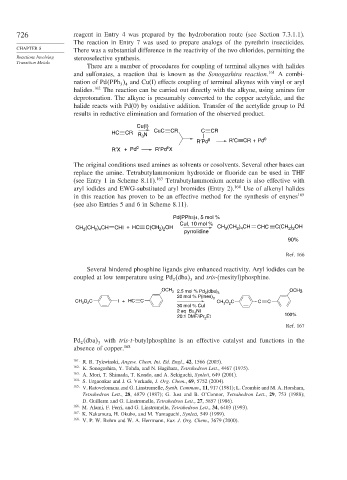Page 750 - Advanced Organic Chemistry Part B - Reactions & Synthesis
P. 750
726 reagent in Entry 4 was prepared by the hydroboration route (see Section 7.3.1.1).
The reaction in Entry 7 was used to prepare analogs of the pyrethrin insecticides.
CHAPTER 8 There was a substantial difference in the reactivity of the two chlorides, permitting the
Reactions Involving stereoselective synthesis.
Transition Metals
There are a number of procedures for coupling of terminal alkynes with halides
and sulfonates, a reaction that is known as the Sonogashira reaction. 161 A combi-
nation of Pd PPh and Cu(I) effects coupling of terminal alkynes with vinyl or aryl
3 4
halides. 162 The reaction can be carried out directly with the alkyne, using amines for
deprotonation. The alkyne is presumably converted to the copper acetylide, and the
halide reacts with Pd(0) by oxidative addition. Transfer of the acetylide group to Pd
results in reductive elimination and formation of the observed product.
Cu(I)
HC CR R N CuC CR C CR
3
R′Pd II R′CCR +Pd 0
II
R′X + Pd 0 R′Pd X
The original conditions used amines as solvents or cosolvents. Several other bases can
replace the amine. Tetrabutylammonium hydroxide or fluoride can be used in THF
(see Entry 1 in Scheme 8.11). 163 Tetrabutylammonium acetate is also effective with
aryl iodides and EWG-substituted aryl bromides (Entry 2). 164 Use of alkenyl halides
in this reaction has proven to be an effective method for the synthesis of enynes 165
(see also Entries 5 and 6 in Scheme 8.11).
Pd(PPh3)4, 5 mol %
CuI, 10 mol %
CH (CH ) CH CHI + HC C(CH ) OH CH 3 (CH ) CH CHC C(CH ) OH
2 2
2 4
2 2
3
2 4
pyrrolidine
90%
Ref. 166
Several hindered phosphine ligands give enhanced reactivity. Aryl iodides can be
coupled at low temperature using Pd dba and tris-(mesityl)phosphine.
2
3
OCH 3 2.5 mol % Pd (dba) 3 OCH 3
2
20 mol % P(mes) 3
O C I + HC C
CH 3 2 CH O C C C
2
3
30 mol % CuI
NI
2 eq Bu 4 100%
Et
20:1 DMF/iPr 2
Ref. 167
Pd dba with tris-t-butylphosphine is an effective catalyst and functions in the
3
2
absence of copper. 168
161
R. R. Tykwinski, Angew. Chem. Int. Ed. Engl., 42, 1566 (2003).
162
K. Sonogashira, Y. Tohda, and N. Hagihara, Tetrahedron Lett., 4467 (1975).
163 A. Mori, T. Shimada, T. Kondo, and A. Sekiguchi, Synlett, 649 (2001).
164
S. Urgaonkar and J. G. Verkade, J. Org. Chem., 69, 5752 (2004).
165
V. Ratovelomana and G. Linstrumelle, Synth. Commun., 11, 917 (1981); L. Crombie and M. A. Horsham,
Tetrahedron Lett., 28, 4879 (1987); G. Just and B. O’Connor, Tetrahedron Lett., 29, 753 (1988);
D. Guillerm and G. Linstrumelle, Tetrahedron Lett., 27, 5857 (1986).
166 M. Alami, F. Ferri, and G. Linstrumelle, Tetrahedron Lett., 34, 6403 (1993).
167 K. Nakamura, H. Okubo, and M. Yamaguchi, Synlett, 549 (1999).
168
V. P. W. Bohm and W. A. Herrmann, Eur. J. Org. Chem., 3679 (2000).

